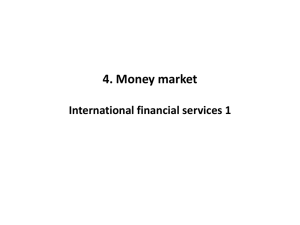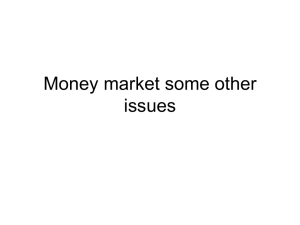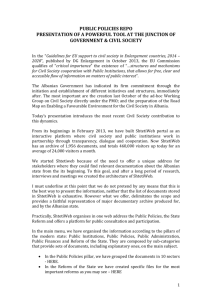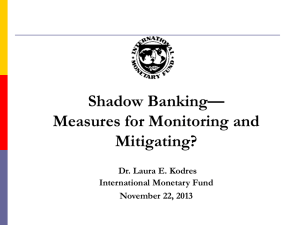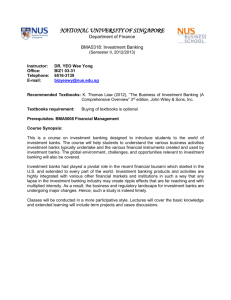Liquidity Hoarding in the Interbank Market: Evidence from Mexican
advertisement
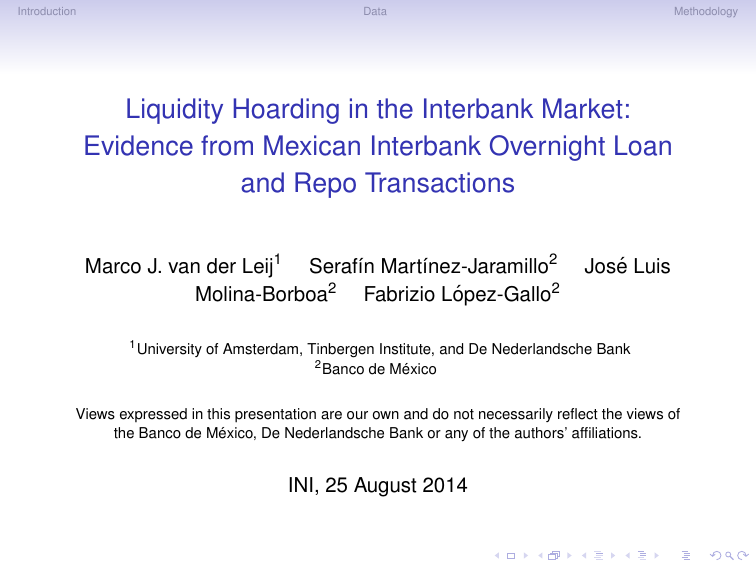
Introduction Data Methodology Liquidity Hoarding in the Interbank Market: Evidence from Mexican Interbank Overnight Loan and Repo Transactions Marco J. van der Leij1 Serafı́n Martı́nez-Jaramillo2 Molina-Borboa2 Fabrizio López-Gallo2 1 José Luis University of Amsterdam, Tinbergen Institute, and De Nederlandsche Bank 2 Banco de México Views expressed in this presentation are our own and do not necessarily reflect the views of the Banco de México, De Nederlandsche Bank or any of the authors’ affiliations. INI, 25 August 2014 Introduction Data Methodology Introduction A focal point of the study of systemic risk and the Global Financial Crisis has been the interbank lending market. This inspired research on contagion in financial networks, both by economists and non-economists • Financial contagion: Alan & Gale (2000) • Ecology of banking system: Haldane & May (Nature, 2011) • Many others Introduction Data Methodology Introduction Most financial network research has focused on potential cascades of insolvency defaults through exposures on unsecured loans. However, such cascades never took place. More relevant in the Global Financial Crisis seems to have been liquidity contagion in (secured) repo lending markets. • Run on Repo market (Gorton & Metrick, 2012) Introduction Data Methodology Introduction Most financial network research has focused on potential cascades of insolvency defaults through exposures on unsecured loans. However, such cascades never took place. More relevant in the Global Financial Crisis seems to have been liquidity contagion in (secured) repo lending markets. • Run on Repo market (Gorton & Metrick, 2012) • Cascade of Liquidity Hoarding (Gai, Haldane & Kapadia, 2011) • Bank A gets hit by a negative shock and reduces or withdraws interbank lending to B and C. • Banks B and C then reduce or withdraw interbank lending to D, E. • This lending withdrawal process may cascade. Introduction Data Methodology Introduction However, evidence is still sparse, in particular on contagion in the interbank market. Main problem is a lack of good high frequency data. • Unsecured Interbank Lending • Filtered from large value payment system transactions, such as Fedwire or TARGET2 (Furfine, 1999). Doubts about reliability (Armantier & Copeland, 2012) • Or transactions from only a part of the market (eMid) • Secured lending through repurchase agreements: Repo market • U.S. Tri-party Repo Market (Copeland et al. 2011) • Central Counterparty Euro Repo (Mancini et al. 2014) • Bilateral Repo between Money Market Funds and banks (Krishnamurthy et al. 2013) Introduction Data Methodology Introduction However, evidence is still sparse, in particular on contagion in the interbank market. Main problem is a lack of good high frequency data. • Unsecured Interbank Lending • Filtered from large value payment system transactions, such as Fedwire or TARGET2 (Furfine, 1999). Doubts about reliability (Armantier & Copeland, 2012) • Or transactions from only a part of the market (eMid) • Secured lending through repurchase agreements: Repo market • U.S. Tri-party Repo Market (Copeland et al. 2011) • Central Counterparty Euro Repo (Mancini et al. 2014) • Bilateral Repo between Money Market Funds and banks (Krishnamurthy et al. 2013) • No data on both unsecured and secured (repo) interbank loans • No data on bilateral interbank repo transactions Introduction Data Methodology Introduction A complete picture is missing. One of the few exceptions is Mexico • The Mexican government tightened banking regulation after the Tequilla crisis in 1994 • The Mexican Central Bank, Banco de México, set up a data warehouse to which all banks are obliged to report data • since 2005 daily data on transactions on unsecured interbank loans, repo transactions, security and derivative holdings in other banks. In this project we consider • Daily data on volume and interest rate • on unsecured and secured (repo) interbank overnight loan transactions • between commercial banks in Mexico • from 2005 to 2013 Introduction Data Methodology Introduction We ask the following question • How do banks in the interbank overnight loan market respond to a negative shock in external repo funding? Introduction Data Methodology Introduction We ask the following question • How do banks in the interbank overnight loan market respond to a negative shock in external repo funding? Results • Banks that are highly dependent on external repo funding increase their repo borrowing and decrease their repo lending to other banks • Some evidence that this effect spills over to the unsecured market as well • No effect on interest rates Introduction Data The Mexican Banking Market Structure of the unsecured interbank loan market • commercial banks, brokerage houses, regional development banks, foreign banks and the central bank can participate • We consider only the interbank market between commercial banks: 27 commercial banks in 2005 to 40 in 2013. • only Mexican peso • only overnight transactions (92%) Methodology Introduction Data Methodology The Mexican Banking Market Structure of the unsecured interbank loan market • commercial banks, brokerage houses, regional development banks, foreign banks and the central bank can participate • We consider only the interbank market between commercial banks: 27 commercial banks in 2005 to 40 in 2013. • only Mexican peso • only overnight transactions (92%) Repo market • Only commercial banks, brokerage houses and regional development banks can borrow on the repo market. Anyone can lend. • Legal requirement on collateral. No repo on asset-backed securities • We consider only commercial banks, repos in Mexican pesos and overnight transactions Introduction Data Repo Network Methodology Introduction Data Methodology Unsecured Interbank Loan Rates Deposits & Loans Interest rate % 10 8 6 4 2006 2008 Date 2010 2012 2014 Introduction Data Methodology Repo Rates Repo Interest rate % 9 7 5 2006 2008 Date 2010 2012 2014 Introduction Data Methodology Unsecured Loan and Repo Volumes 250 200 150 Volume Market Deposits & loans Repos 100 50 0 2006 2008 Date 2010 2012 2014 Introduction Data Borrowing and lending in repo market Methodology Introduction Data Borrowing and lending in unsecured market Methodology Introduction Data Shock identification We identify a negative shock to external repo funding as follows • We consider the total log amount of daily repo funding from legal entities and physical persons to commercial banks • We take the 10% days with lowest total funding relative to a Hodrick-Prescott filter with a 21-day window • Shock dummy variable wt is 1 if day t is one of the 10% lowest funding days This variable seems to measure supply shocks rather than demand shocks. Methodology Introduction Data Construction shock variable Methodology Introduction Data Methodology Methodology We analyze the response in borrowing and lending of banks that are dependent on external repo funding on a negative shock in total external repo funding relative to those banks that are not dependent on external repo funding • dependent variable: for bank i at day d • Log Transaction Volume or Weighted average interest rate • Borrowing or Lending • Secured Repo or unsecured loans Introduction Data Methodology Methodology We analyze the response in borrowing and lending of banks that are dependent on external repo funding on a negative shock in total external repo funding relative to those banks that are not dependent on external repo funding • dependent variable: for bank i at day d • Log Transaction Volume or Weighted average interest rate • Borrowing or Lending • Secured Repo or unsecured loans • regressors • assets, dependence on external repo funding, shock dummy, interaction variables • Regressor of interest: dependence on external repo funding X shock dummy Introduction Data Methodology Methodology We analyze the response in borrowing and lending of banks that are dependent on external repo funding on a negative shock in total external repo funding relative to those banks that are not dependent on external repo funding • dependent variable: for bank i at day d • Log Transaction Volume or Weighted average interest rate • Borrowing or Lending • Secured Repo or unsecured loans • regressors • assets, dependence on external repo funding, shock dummy, interaction variables • Regressor of interest: dependence on external repo funding X shock dummy • Models: OLS, Fixed effects with lag dependent variable, Heckman sample selection model with fixed effects dummies and lag dependent variable Introduction Data Methodology Effect on Log Amount of Repo Borrowing Share External Repo Assets (Normalized) Shock indicator Shock X Share External Repo Shock X Assets OLS -1.873∗∗∗ (0.0278) 13.98∗∗∗ (0.103) -0.102∗∗ (0.0342) 0.193∗ (0.0828) -0.454 (0.300) FE LS 0.301∗∗∗ (0.0551) 2.721∗∗∗ (0.466) -0.00192 (0.0297) 0.0987 (0.0707) -0.0126 (0.257) 0.671∗∗∗ (0.00842) No No 37403 Yes Yes 37403 Log Borrowed Amount (d − 21 to d − 1) Inverse Mills Borrower dummies Month dummies Observations ∗p < 0.05, ∗∗ p < 0.01, ∗∗∗ p < 0.001 Heckman 2-step -0.132∗∗ -0.0336 (0.0463) (0.0774) 5.038∗∗∗ 2.621∗∗∗ (1.182) (0.549) -0.0812∗ -0.0658 (0.0378) (0.0360) 0.178∗ 0.312∗∗ (0.0813) (0.106) 1.614∗∗ 0.404 (0.570) (0.338) 0.488∗∗∗ 1.127∗∗∗ (0.00747) (0.0156) 2.146∗∗∗ (0.0772) Yes Yes Yes Yes 53028 37403 Introduction Data Methodology Effect on Log Amount of Repo Lending Share External Repo Assets (Normalized) Shock indicator Shock X Share External Repo Shock X Assets OLS 0.353∗∗∗ (0.0219) 10.32∗∗∗ (0.105) 0.0770 (0.0418) -0.408∗∗∗ (0.0774) -0.258 (0.303) FE LS 0.136∗∗∗ (0.0326) -1.490∗ (0.696) 0.108∗∗∗ (0.0317) -0.222∗∗∗ (0.0513) 0.0231 (0.254) 0.637∗∗∗ (0.00648) No No 34423 Yes Yes 34423 Log Lent Amount (day d − 21 to d − 1) Inverse Mills Ratio Borrower dummies Month dummies Observations ∗p < 0.05, ∗∗ p < 0.01, ∗∗∗ p < 0.001 Heckman 2-step 0.347∗∗∗ 0.463∗∗∗ (0.0423) (0.0483) 7.694∗∗∗ 5.901∗∗∗ (1.030) (0.808) 0.0416 0.109∗ (0.0335) (0.0483) -0.0757 -0.216∗∗ (0.0757) (0.0824) 1.050∗∗ 0.729∗ (0.403) (0.343) 0.483∗∗∗ 1.116∗∗∗ (0.00729) (0.0150) 2.113∗∗∗ (0.0733) Yes Yes Yes Yes 51816 34423 Introduction Data Methodology Effect on Log Amount of Unsecured Borrowing Share External Repo Assets (Normalized) Shock indicator Shock X Share External Repo Shock X Assets OLS 0.156∗∗∗ (0.0361) 18.01∗∗∗ (0.118) -0.322∗∗∗ (0.0806) 0.236 (0.131) 0.749 (0.394) FE LS 0.374∗∗∗ (0.0819) -1.403 (0.894) -0.0726 (0.0641) 0.0874 (0.106) 0.502 (0.341) 0.563∗∗∗ (0.0140) No No 19585 Yes Yes 19585 Log Borrowed Amount (day d − 21 to d − 1) Inverse Mills Ratio Borrower dummies Month dummies Observations ∗p < 0.05, ∗∗ p < 0.01, ∗∗∗ p < 0.001 Heckman 2-step 0.420∗∗∗ 0.654∗∗∗ (0.0638) (0.0904) 7.714∗∗∗ 6.384∗∗∗ (1.116) (1.178) -0.0686 -0.199∗ (0.0421) (0.0982) 0.00949 0.196 (0.0887) (0.173) 0.998∗ 1.371∗∗ (0.454) (0.465) 0.357∗∗∗ 1.136∗∗∗ (0.00942) (0.0351) 2.762∗∗∗ (0.162) Yes Yes Yes Yes 40860 19585 Introduction Data Methodology Effect on Log Amount of Unsecured Lending Share External Repo Assets (Normalized) Shock indicator Shock X Share External Repo Shock X Assets OLS 0.579∗∗∗ (0.0387) 16.72∗∗∗ (0.158) -0.257∗∗ (0.0980) 0.0125 (0.159) 1.484∗∗ (0.535) FE LS 0.631∗∗∗ (0.0958) 13.87∗∗∗ (1.282) -0.115 (0.0798) -0.00155 (0.128) 1.437∗∗ (0.493) -0.194∗∗∗ (0.0152) No No 16398 Yes Yes 16398 Log Lent Amount (day d − 21 to d − 1) Inverse Mills Borrower dummies Month dummies Observations ∗p < 0.05, ∗∗ p < 0.01, ∗∗∗ p < 0.001 Heckman 2-step 0.120 0.594∗∗ (0.0614) (0.183) 14.40∗∗∗ -12.97∗∗ (0.925) (4.231) -0.0314 -0.0289 (0.0439) (0.121) 0.149 -0.343∗ (0.0874) (0.170) 0.890∗∗ -0.222 (0.320) (0.748) 0.102∗∗∗ -0.404∗∗∗ (0.00777) (0.0313) -3.337∗∗∗ (0.447) Yes Yes Yes Yes 44004 16398 Introduction Data Methodology Effect on Borrowing Interest Rate Share External Repo Assets (Normalized) Shock indicator Shock X Share External Repo Shock X Assets Median Borrower Spread (day d − 21 to d − 1) Inverse Mills Ratio Borrower dummies Month dummies Observations ∗p Repo -0.00675∗ -0.0193∗∗∗ (0.00299) (0.00477) -0.334∗∗∗ 0.244∗∗∗ (0.0116) (0.0536) 0.0122∗ 0.0124∗∗∗ (0.00599) (0.00333) -0.0142 -0.0103 (0.00976) (0.00826) -0.111∗∗ -0.00551 (0.0379) (0.0357) 0.727∗∗∗ (0.0126) -0.00380 (0.00333) No Yes No Yes 37403 37403 < 0.05, ∗∗ p < 0.01, ∗∗∗ p < 0.001 Unsecured 0.0102∗∗∗ -0.00333 (0.00186) (0.00443) -0.216∗∗∗ -0.485∗∗∗ (0.0128) (0.0819) 0.0187∗∗∗ 0.00451 (0.00427) (0.00249) -0.00100 -0.00275 (0.00595) (0.00473) 0.0261 -0.00432 (0.0250) (0.0275) 0.319∗∗∗ (0.0178) -0.00937 (0.00251) No Yes No Yes 19584 19584 Introduction Data Methodology Effect on Lending Interest Rate Share External Repo Assets (Normalized) Shock indicator Shock X Share External Repo Shock X Assets Median Lender Spread (day d − 21 to d − 1) Inverse Mills Ratio Borrower dummies Month dummies Observations ∗p Repo 0.0397∗∗∗ 0.0214∗∗∗ (0.00243) (0.00394) 7.694∗∗∗ -0.276∗∗ (0.0167) (0.0998) 0.00782 0.000716 (0.00807) (0.00588) -0.0206∗ 0.00734 (0.00957) (0.00888) -0.00971 -0.0122 (0.0510) (0.0433) 0.752∗∗∗ (0.00967) 0.000305 (0.00312) No Yes No Yes 34424 34424 < 0.05, ∗∗ p < 0.01, ∗∗∗ p < 0.001 Unsecured -0.0304∗∗∗ 0.00437 (0.00283) (0.00620) 0.508∗∗∗ -0.967∗∗∗ (0.0102) (0.131) 0.00173 -0.00248 (0.00566) (0.00505) 0.00185 -0.00776 (0.00850) (0.0101) -0.0889 -0.0573∗ (0.0294) (0.0272) 0.471∗∗∗ (0.0251) -0.0453∗∗∗ (0.0127) No Yes No Yes 16395 16395 Introduction Data Methodology Conclusions • Study of the Mexican interbank overnight market • First results: Banks that are affected by a negative external repo shock reduce their interbank lending • Does this reduction spill over to other banks? Future work • How do lending relationships matter?
